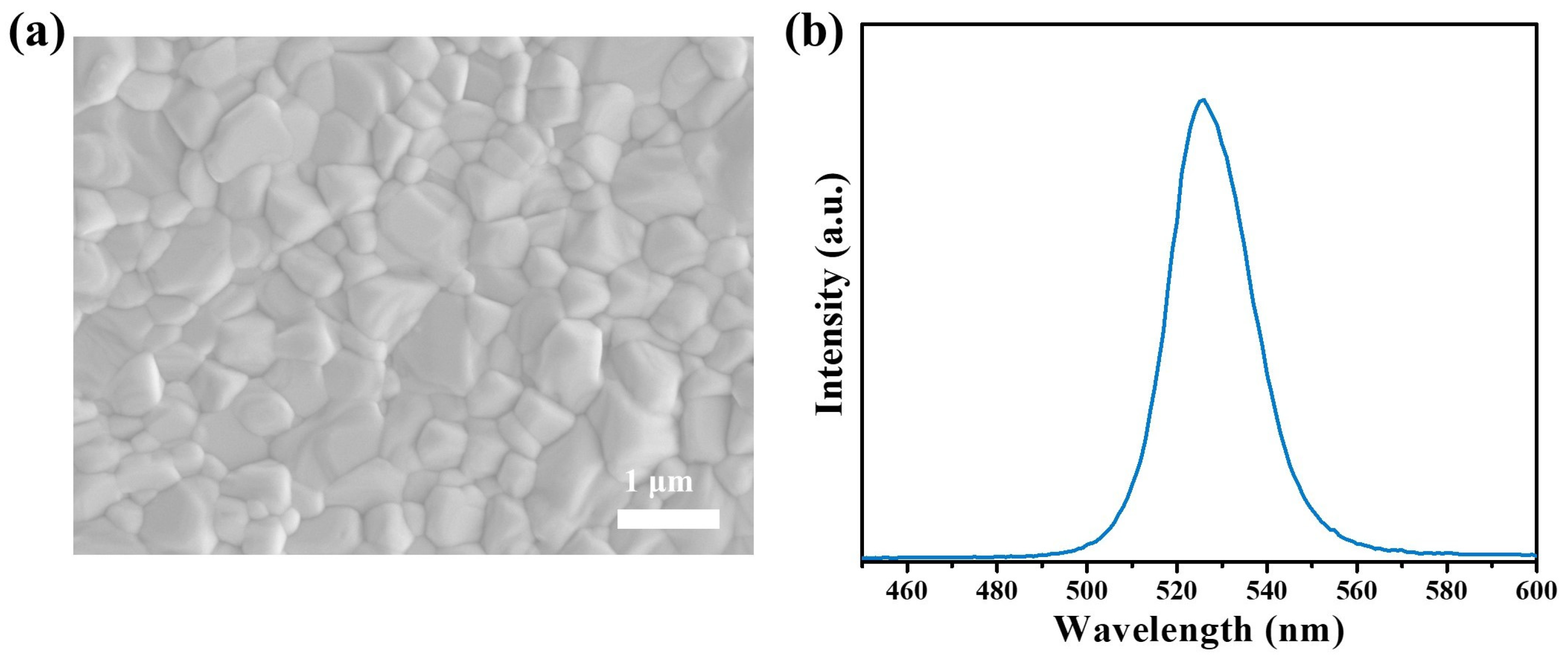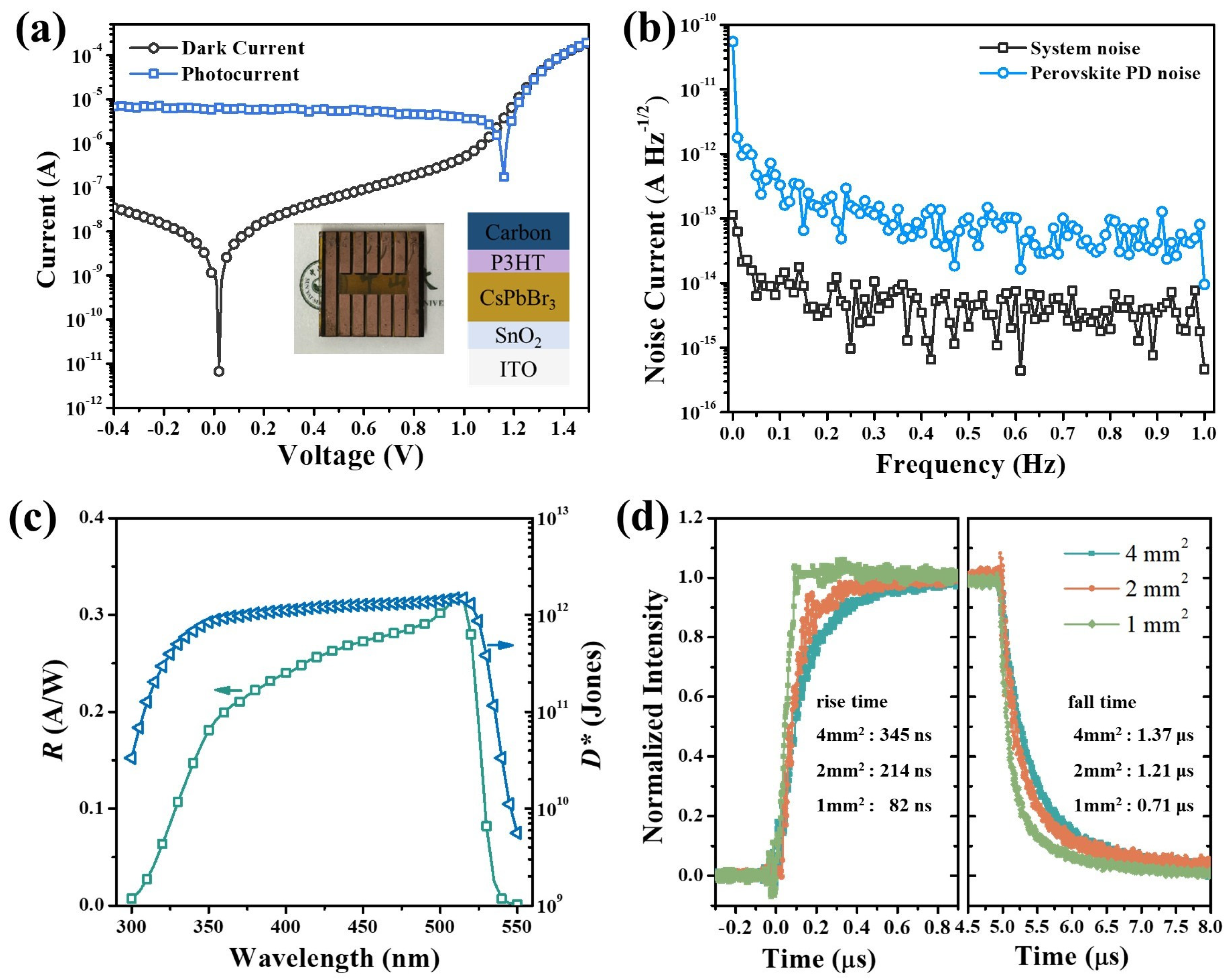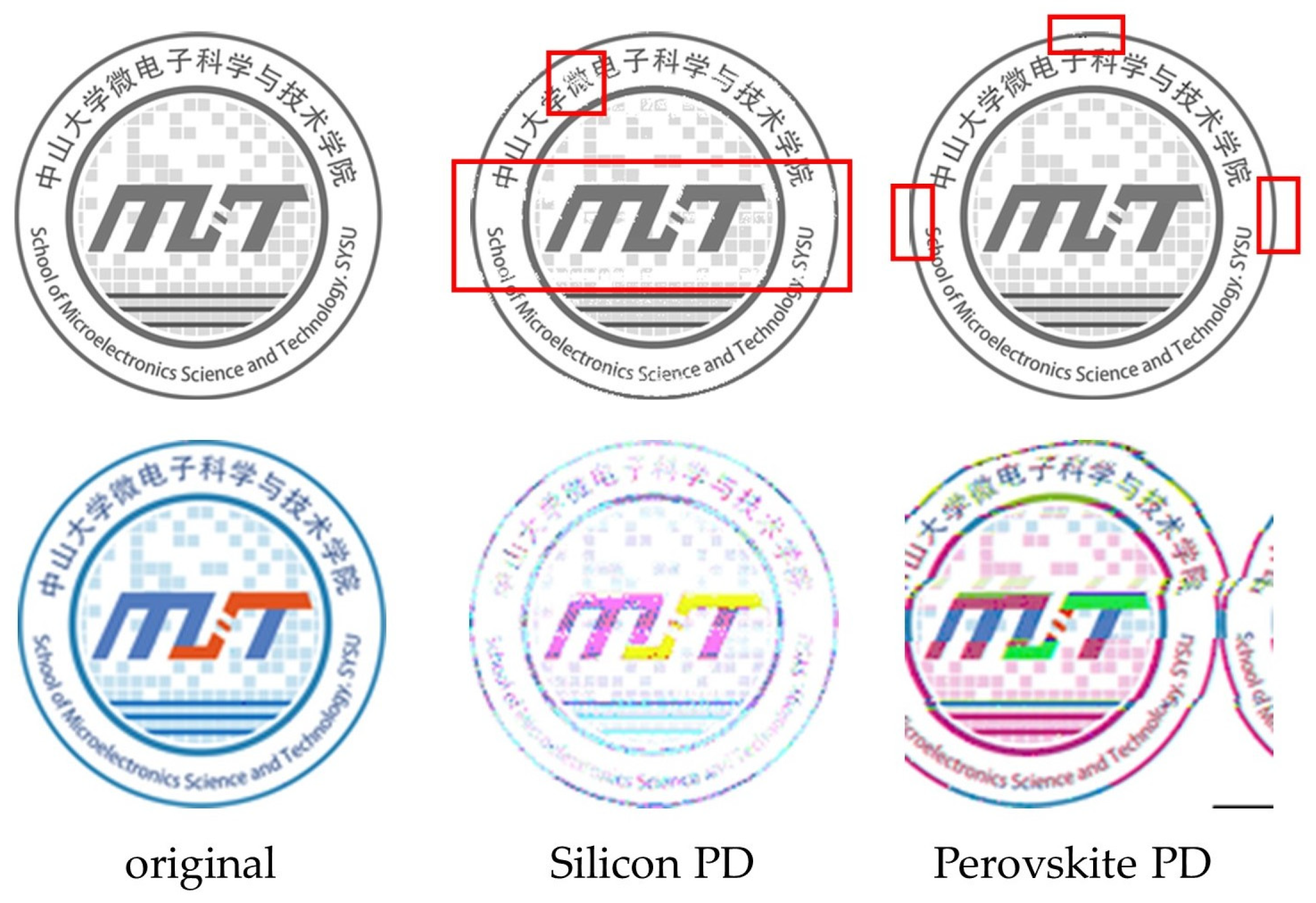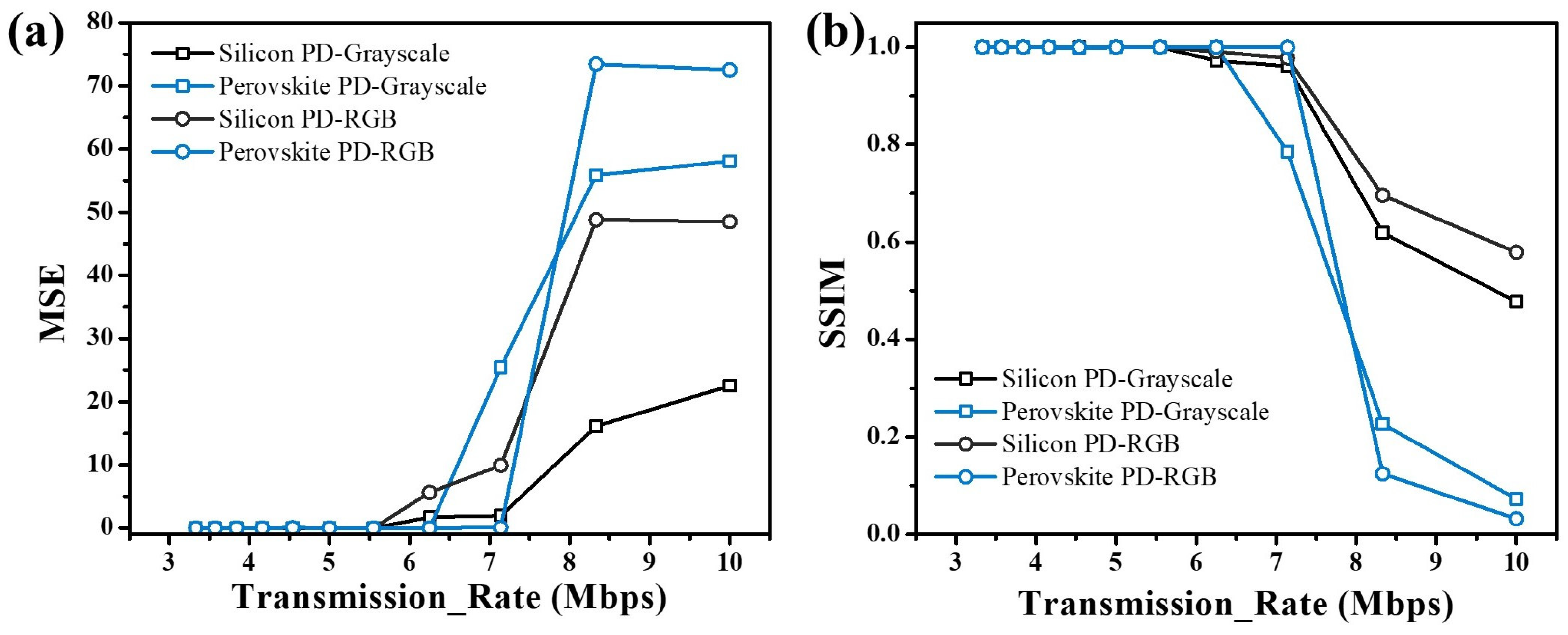Solution-Processed CsPbBr3 Perovskite Photodetectors for Cost-Efficient Underwater Wireless Optical Communication System
Abstract
1. Introduction
2. Materials and Methods
2.1. Photodetector Fabrication
- Materials and Reagents
- Device Fabrication
- Characterizations
2.2. Underwater Wireless Optical Communication System Construction
- Physical Implementation
- Working Mechanism
3. Results and Discussion
3.1. The Performance of Solution-Processed Perovskite PDs
3.2. The UWOC Application
4. Conclusions
Author Contributions
Funding
Data Availability Statement
Acknowledgments
Conflicts of Interest
References
- Lacovara, P.A. High-Bandwidth Underwater Communications. Mar. Technol. Soc. J. 2008, 42, 93–102. [Google Scholar] [CrossRef]
- Yang, C.; Wang, L.; Peng, C.; Zhang, S.; Cui, Y.; Ma, C. A Robust Time-Frequency Synchronization Method for Underwater Acoustic OFDM Communication Systems. IEEE Access 2024, 12, 21908–21920. [Google Scholar] [CrossRef]
- Akyildiz, I.F.; Pompili, D.; Melodia, T. Challenges for efficient communication in underwater acoustic sensor networks. SIGBED Rev. 2004, 1, 3–8. [Google Scholar] [CrossRef]
- Al-Tameemi, H.M.; Idris, A.; Sarnin, S.S.; Idris, S.H. Underwater acoustic communication systems: An overview. AIP Conf. Proc. 2023, 2977, 020008. [Google Scholar]
- Lou, Y.; Ahmed, N. UWAC Challenges and Research Trends. In Underwater Communications and Networks; Springer International Publishing: Cham, Switzerland, 2022; pp. 99–115. [Google Scholar]
- Partan, J.; Kurose, J.; Levine, B.N. A survey of practical issues in underwater networks. SIGMOBILE Mob. Comput. Commun. Rev. 2007, 11, 23–33. [Google Scholar] [CrossRef]
- Zhu, S.; Chen, X.; Liu, X.; Zhang, G.; Tian, P. Recent progress in and perspectives of underwater wireless optical communication. Prog. Quant. Electron. 2020, 73, 100274. [Google Scholar] [CrossRef]
- Li, X.; Cheng, C.; Wei, Z.; Fu, H.Y.; Yang, Y.; Hu, W. Net 5.75 Gbps/2 m Single-Pixel Blue Mini-LED Based Underwater Wireless Communication System Enabled by Partial Pre-Emphasis and Nonlinear Pre-Distortion. J. Light. Technol. 2022, 40, 6116–6122. [Google Scholar] [CrossRef]
- Liu, W.; Ye, Z.; Huang, N.; Li, S.; Xu, Z. Multilevel polarization shift keying modulation for turbulence-robust underwater optical wireless communication. Opt. Express 2023, 31, 8400–8413. [Google Scholar] [CrossRef]
- Baykal, Y.; Ata, Y.; Gökçe, M.C. Underwater turbulence, its effects on optical wireless communication and imaging: A review. Opt. Laser Technol. 2022, 156, 108624. [Google Scholar] [CrossRef]
- Joseph, L.; Anandan, S. A Review on Feasible and Reliable Underwater Wireless Optical Communication System for achieving High Data Rate and Longer Transmission Distance. Int. J. Electron. Telecommun. 2022, 68, 815–823. [Google Scholar] [CrossRef]
- Zhang, C.; Yang, X.; Zou, H.; Zhang, H.; Zhang, Y.; Dai, Y.; Song, G.; Zhang, Z.; Wu, B.; Xu, J. 9.14-Mbps 64-PPM UWOC system based on a directly modulated MOPA with pre-pulse shaping and a high-sensitivity PMT with analog demodulation. Opt. Express 2022, 30, 30233–30245. [Google Scholar] [CrossRef] [PubMed]
- Fei, C.; Wang, Y.; Du, J.; Chen, R.; Lv, N.; Zhang, G.; Tian, J.; Hong, X.; He, S. 100-m/3-Gbps underwater wireless optical transmission using a wideband photomultiplier tube (PMT). Opt. Express 2022, 30, 2326–2337. [Google Scholar] [CrossRef] [PubMed]
- Chen, X.; Dai, Y.; Tong, Z.; Yang, X.; Li, X.; Song, G.; Zou, H.; Jia, B.; Qin, S.; Zhang, Z.; et al. Demonstration of a 2 × 2 MIMO-UWOC system with large spot against air bubbles. Appl. Opt. 2022, 61, 41–48. [Google Scholar] [CrossRef] [PubMed]
- Xie, Y.; Wang, Y.; Kandeepan, S.; Wang, K. Machine Learning Applications for Short Reach Optical Communication. Photonics 2022, 9, 30. [Google Scholar] [CrossRef]
- Fang, C.; Li, S.; Wang, Y.; Wang, K. High-Speed Underwater Optical Wireless Communication with Advanced Signal Processing Methods Survey. Photonics 2023, 10, 811. [Google Scholar] [CrossRef]
- Yuan, G.; Cao, Z.; Wang, S.; Liu, S.; An, Q. Application of FPGA Acceleration in ADC Performance Calibration. arXiv 2018, arXiv:1806.04716. [Google Scholar]
- Ricci, S.; Caputo, S.; Mucchi, L. FPGA-Based Visible Light Communications Instrument for Implementation and Testing of Ultralow Latency Applications. IEEE Trans. Instrum. Meas. 2023, 72, 2004811. [Google Scholar] [CrossRef]
- Li, X.; Gui, L.; Xia, Y.; Lang, L. Demonstration of a Real-Time UWOC System Using a Bandwidth Limited LED Based on Hardware and Software Equalization. J. Light. Technol. 2023, 41, 4979–4988. [Google Scholar] [CrossRef]
- Wang, P.; Li, C.; Xu, Z. A Cost-Efficient Real-Time 25 Mb/s System for LED-UOWC: Design, Channel Coding, FPGA Implementation, and Characterization. J. Light. Technol. 2018, 36, 2627–2637. [Google Scholar] [CrossRef]
- Doniec, M.; Vasilescu, I.; Chitre, M.; Detweiler, C.; Hoffmann-Kuhnt, M.; Rus, D. AquaOptical: A Lightweight Device for High-Rate Long-Range Underwater Point-to-Point Communication. Mar. Technol. Soc. J. 2010, 44, 55–65. [Google Scholar] [CrossRef]
- Doniec, M.; Anqi, X.; Rus, D. Robust real-time underwater digital video streaming using optical communication. In Proceedings of the 2013 IEEE International Conference on Robotics and Automation, Karlsruhe, Germany, 6–10 May 2013; pp. 5117–5124. [Google Scholar]
- Zhang, Z.; Lai, Y.; Lv, J.; Liu, P.; Teng, D.; Wang, G.; Liu, L. Over 700 MHz–3dB Bandwidth UOWC System Based on Blue HV-LED With T-Bridge Pre-Equalizer. IEEE Photonics J. 2019, 11, 7903812. [Google Scholar] [CrossRef]
- Chi, N.; Shi, M. Enabling technologies for high-speed LED based underwater visible light communications. In Proceedings of the 2019 IEEE International Conference on Signal Processing, Communications and Computing (ICSPCC), Dalian, China, 20–22 September 2019; pp. 1–4. [Google Scholar]
- Duntley, S.Q. Light in the Sea. J. Opt. Soc. Am. 1963, 53, 214–233. [Google Scholar] [CrossRef]
- Zhang, H.; Liu, X.; Dong, J.; Yu, H.; Zhou, C.; Zhang, B.; Xu, Y.; Jie, W. Centimeter-Sized Inorganic Lead Halide Perovskite CsPbBr3 Crystals Grown by an Improved Solution Method. Cryst. Growth Des. 2017, 17, 6426–6431. [Google Scholar] [CrossRef]
- He, L.; Li, M.; Chen, Q.; Sun, R.; Wang, F.; Wang, X.; Wu, H.; Wei, W.; Qin, T.; Shen, L. Self-Powered and Low-Noise Perovskite Photodetector Enabled by a Novel Dopant-Free Hole-Transport Material with Bottom Passivation for Underwater Blue Light Communications. ACS Appl. Mater. Interfaces 2022, 14, 46809–46818. [Google Scholar] [CrossRef]
- Zhou, X.; Luo, L.; Huang, Y.; Wei, S.; Zou, J.; He, A.; Huang, B.; Li, X.; Zhao, J.; Shen, K.; et al. Macroscopic and microscopic defect management in blue/green photodetectors for underwater wireless optical communication. J. Mater. Chem. C 2022, 10, 5970–5980. [Google Scholar] [CrossRef]
- Yu, D.; Cao, F.; Gu, Y.; Han, Z.; Liu, J.; Huang, B.; Xu, X.; Zeng, H. Broadband and sensitive two-dimensional halide perovskite photodetector for full-spectrum underwater optical communication. Nano Res. 2020, 14, 1210–1217. [Google Scholar] [CrossRef]
- Zhu, H.; Chen, H.; Fei, J.; Deng, Y.; Yang, T.; Chen, P.; Liang, Y.; Cai, Y.; Zhu, L.; Huang, Z. Solution-processed CsPbBr3 perovskite films via CsBr intercalated PbBr2 intermediate for high-performance photodetectors towards underwater wireless optical communication. Nano Energy 2024, 125, 109513. [Google Scholar] [CrossRef]
- Datasheet of Silicon Photodetector (S1226-18BK) from, HAMAMATSU. Available online: https://www.hamamatsu.com.cn/cn/zh-cn/product/optical-sensors/photodiodes/si-photodiodes/S1226-18BK.html (accessed on 25 August 2024).
- Zhang, H.; Wang, F.; Lu, Y.; Sun, Q.; Xu, Y.; Zhang, B.-B.; Jie, W.; Kanatzidis, M.G. High-sensitivity X-ray detectors based on solution-grown caesium lead bromide single crystals. J. Mater. Chem. C 2020, 8, 1248–1256. [Google Scholar] [CrossRef]
- Liu, J.-M. Photonic Devices; Cambridge University Press: Cambridge, UK, 2005. [Google Scholar]
- Bao, C.; Yang, J.; Bai, S.; Xu, W.; Yan, Z.; Xu, Q.; Liu, J.; Zhang, W.; Gao, F. High Performance and Stable All-Inorganic Metal Halide Perovskite-Based Photodetectors for Optical Communication Applications. Adv. Mater. 2018, 30, e1803422. [Google Scholar] [CrossRef]
- Zhu, H.L.; Liang, Z.; Huo, Z.; Ng, W.K.; Mao, J.; Wong, K.S.; Yin, W.-J.; Choy, W.C.H. Low-Bandgap Methylammonium-Rubidium Cation Sn-Rich Perovskites for Efficient Ultraviolet-Visible-Near Infrared Photodetectors. Adv. Funct. Mater. 2018, 28, 1706068. [Google Scholar] [CrossRef]
- Bull, D.R.; Zhang, F. Chapter 11—Communicating pictures: Delivery across networks. In Intelligent Image and Video Compression, 2nd ed.; Bull, D.R., Zhang, F., Eds.; Academic Press: Oxford, UK, 2021; pp. 385–434. [Google Scholar]
- Yuan, Z.; Zhao, X. Introduction of forward error correction and its application. In Proceedings of the 2012 2nd International Conference on Consumer Electronics, Communications and Networks (CECNet), Yichang, China, 21–23 April 2012; pp. 3288–3291. [Google Scholar]








Disclaimer/Publisher’s Note: The statements, opinions and data contained in all publications are solely those of the individual author(s) and contributor(s) and not of MDPI and/or the editor(s). MDPI and/or the editor(s) disclaim responsibility for any injury to people or property resulting from any ideas, methods, instructions or products referred to in the content. |
© 2024 by the authors. Licensee MDPI, Basel, Switzerland. This article is an open access article distributed under the terms and conditions of the Creative Commons Attribution (CC BY) license (https://creativecommons.org/licenses/by/4.0/).
Share and Cite
Wei, J.; Deng, Y.; Fei, J.; Yang, T.; Chen, P.; Zhu, L.; Huang, Z. Solution-Processed CsPbBr3 Perovskite Photodetectors for Cost-Efficient Underwater Wireless Optical Communication System. Micromachines 2024, 15, 1185. https://doi.org/10.3390/mi15101185
Wei J, Deng Y, Fei J, Yang T, Chen P, Zhu L, Huang Z. Solution-Processed CsPbBr3 Perovskite Photodetectors for Cost-Efficient Underwater Wireless Optical Communication System. Micromachines. 2024; 15(10):1185. https://doi.org/10.3390/mi15101185
Chicago/Turabian StyleWei, Jiakang, Yutong Deng, Jianjian Fei, Tian Yang, Pinhao Chen, Lu Zhu, and Zhanfeng Huang. 2024. "Solution-Processed CsPbBr3 Perovskite Photodetectors for Cost-Efficient Underwater Wireless Optical Communication System" Micromachines 15, no. 10: 1185. https://doi.org/10.3390/mi15101185
APA StyleWei, J., Deng, Y., Fei, J., Yang, T., Chen, P., Zhu, L., & Huang, Z. (2024). Solution-Processed CsPbBr3 Perovskite Photodetectors for Cost-Efficient Underwater Wireless Optical Communication System. Micromachines, 15(10), 1185. https://doi.org/10.3390/mi15101185







